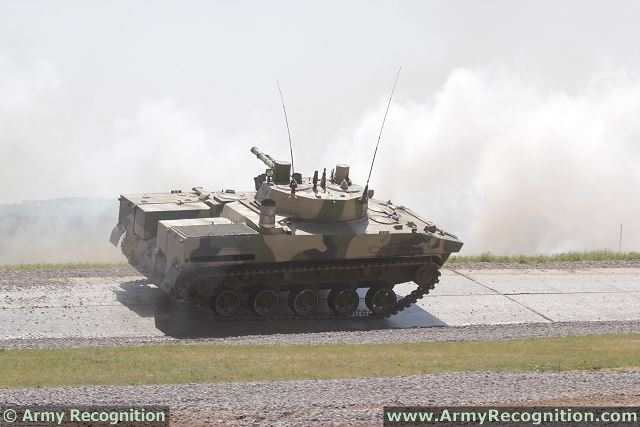Breaking news
Russian airborne troops to be reinforced with six tank battalions of T-72B3M main battle tanks TASS 2005161.
| Archives
|
|
|||
|
Defence & Security News - Russia
|
|||
|
|
|||
| Russian airborne troops to be reinforced with six tank battalions of T-72B3M main battle tanks. | |||
|
In the second half of 2016 the Russian airborne troops will begin the formation of six tank companies which by 2018 will develop in strength into tank battalions. They will be armed with modernized T-72B3M tanks, Free Press online publication expert Sergey Ishchenko said. Foreign experts also noted plans of the Russian defense ministry to enhance the combat power of the airborne troops. They wonder what is the reason for urgent reinforcement of paratroopers with heavy armor which only the ground forces have so far?
|
|||
|
|
|||
 Russian army T-72B3M main battle tank at defense exhibition near Moscow, Russia. Russian army T-72B3M main battle tank at defense exhibition near Moscow, Russia. |
|||
|
|
|||
|
National Interest editor Dave Majumdar believes the tanks will provide additional offensive capabilities to mobile mechanized forces. However the problem is that T-72 tanks cannot be air dropped. It is therefore unclear which role T-72B3M will play as they cannot be dropped together with paratroopers into a combat area.
Airborne troops commander Vladimir Shatalov recently explained: "Naturally, we are not going to parachute tanks. But the airborne forces have two types of units and formations - paraborne and air assault. The former parachutes troops and hardware beyond the frontline. The latter are delivered by aircraft and helicopters to already seized airfields and sites. In those formations - two air assault divisions and four brigades - we shall create T-72 tank companies which will later develop into battalions. There is nothing new in it. It was the strength of the 103rd airborne division that fought in Afghanistan." In 1984 the war in Afghanistan was in full swing and the 103rd airborne division received an independent T-62D tank battalion. It was created on the basis of self-propelled artillery squadron armed with 22 ASU-85 guns and therefore the number of tanks in the battalion was the same. A tank battalion of the ground forces has more armor - 31 vehicles and its fire power is consequently much stronger. However the tank force received by the 103rd division in Afghanistan helped intensify fire support to airborne units on the battlefield. It was prompted by combat experience in the Central Asian country. Majmundar said in contrast to airmobile US units the Russian force is fully mechanized and all the hardware can be parachuted, including the latest airborne fighting vehicle BMD-4M which has just begun to be supplied to the troops. |
|||
|
|
|||
 Russian airborne armoured infantry fighting vehicle BMD-4M in live demonstration during defense exhibition near Moscow, Russia. Russian airborne armoured infantry fighting vehicle BMD-4M in live demonstration during defense exhibition near Moscow, Russia. |
|||
|
|
|||
|
National Interest editor said BMD-4M has big fire power due to 100-mm gun with low impinging gas pressure, a 30-mm gun, a 7.62-mm caliber machinegun, and an anti-tank missile complex. The vehicle is equipped with light aluminum armor to protect it from 30-mm shells. Despite all mounted weapons the vehicle weighs close to 13.5 tons. Besides, the BMD can engage in combat right after landing as the crew is parachuted inside the vehicle. The author said the US army has nothing of the kind.
Russian airborne divisions are urgently armed with the vehicle whose firepower is comparable to that of tanks. By the end of the year the troops will receive 144 BMD-4M, said Nikolai Khokhlov, deputy executive director for armor of the Design bureau for device-making. The planned reinforcement of the airborne troops is no surprise for Deputy Director of the Institute for Political and Military Analysis Alexander Khramchikhin. He said the airborne troops are the most combat capable in the Russian army and their status equals to rapid reaction force. They can be engaged in completely different situations and it is not ruled out that paratroopers may need modern tanks in some of them. The expert believes such tank units can be used in any theater of warfare where the Russian aviation and air defense can win absolute air supremacy, e.g. in Central Asia and Syria. NATO countries will hardly allow unimpeded airborne assault on their airfields. Air supremacy at the theater of warfare is not the only problem to be resolved by airlifting T-72B3M tanks to a seized hostile airfield. The task has been complicated by a major weakening of the military-transport aviation in the past years. It now has only two types of aircraft capable of airlifting such heavy cargoes - An-124 Ruslan and Il-76 of various modifications. The former can carry not more than three medium tanks, the latter - one vehicle. Thus, to airlift one tank company (10 vehicles) four sorties of Ruslan and ten of Il-76 are necessary. However, according to various report,s the Russian Aerospace forces currently have from 7 to 14 An-124 airlifters and close to a hundred Il-76. The data regularly needs to be adjusted as the air campaign in Syria is ongoing and exhausting the resource of available craft, Ischenko writes in Free Press online publication. |
|||
|
|
|||
|
© Copyright 2016 TASS. All rights reserved. This material may not be published, broadcast, rewritten or redistributed.
|
|||



















